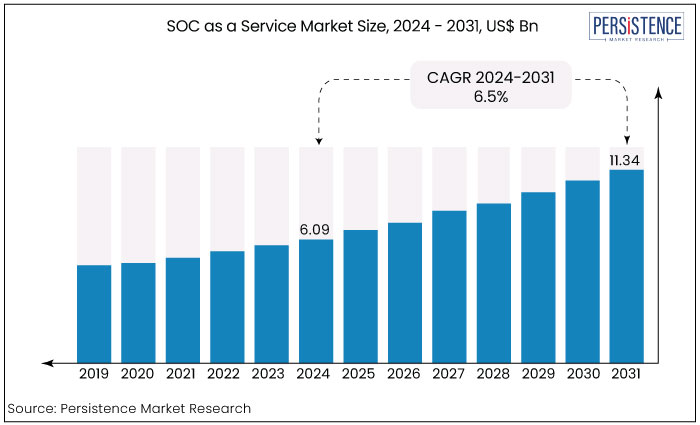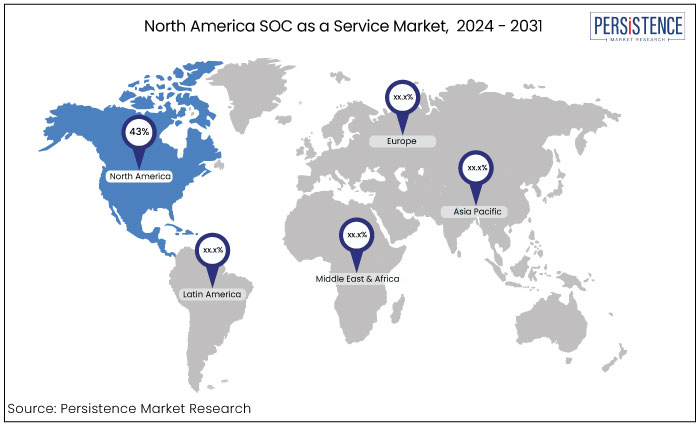SOC as a Service Market
Industry: IT and Telecommunication
Published Date: September-2024
Format: PPT*, PDF, EXCEL
Delivery Timelines: Contact Sales
Number of Pages: 171
Report ID: PMRREP34789
The SOC as a service market is estimated to increase from US$6.09 Bn in 2024 to US$11.34 Bn by 2031. The market is projected to record a CAGR of 6.5% during the forecast period from 2024 to 2031. Increasing cybersecurity threats and cloud adoption along with the advent of AI and machine learning in the industry drives market growth over the forecast period. Europe is predicted to exhibit high growth rate in terms of revenue share.

Key Highlights of the Market
|
Market Attributes |
Key Insights |
|
Market Size (2024E) |
US$6.09 Bn |
|
Projected Market Value (2031F) |
US$11.34 Bn |
|
Global Market Growth Rate (CAGR 2024 to 2031) |
6.5% |
|
Historical Market Growth Rate (CAGR 2019 to 2023) |
6% |
|
Region |
Market Share in 2024 |
|
North America |
43% |
SoC as a service market to capture the notable share of 43%. The expansion of IT and cloud infrastructures is a significant catalyst for the industry growth in North America. As IT infrastructures get increasingly intricate due to the proliferation of cloud, hybrid, and multi-cloud configurations, enterprises have intensified security challenges.
SOC as a Service mitigates these difficulties by providing specialized expertise for the effective management and protection of varied IT infrastructures. The growing utilization of cloud services by North America organizations intensifies this requirement.
Organizations require cloud-native SOC solutions to safeguard data and applications hosted in the cloud, guaranteeing thorough protection against emerging threats. SOC services deliver sophisticated tools and functionalities essential for protecting cloud environments facilitating real-time monitoring, threat identification, and incident management.
Utilizing SOC as a service enables organizations to effectively safeguard their growing and intricate IT infrastructures ensuring strong security and compliance throughout their whole network.

|
Category |
Market Share in 2024 |
|
Service - Managed Detection & Response |
34% |
Based on service, the SOS as a Service market is classified into managed detection & response, prevention service, and incident response services. Among these, the managed detection and response segment dominates the market.
The managed detection and response has been leading the market due to its comprehensive approach to threat detection, incident response, and continuous monitoring. MDR services are highly valued for their ability to provide real-time threat intelligence, advanced analytics, and rapid response capabilities making them crucial component of modern cybersecurity strategies.
|
Category |
Market Share in 2024 |
|
End Use - BFSI |
28% |
Based on end use, the market is categorized into BFSI, healthcare, manufacturing and government. Among these, the BFSI indsutry dominates the market. BFSI institutions represent prime targets for cybercriminals owing to their management of sensitive financial information and substantial transactions.
The prevalence and complexity of assaults including fraud, ransomware, and data breaches, have escalated requiring enhanced security protocols. SOC as a service fulfils these requirements by providing advanced threat detection, continuous monitoring, and incident response functionalities. These services allow BFSI firms to proactively detect and address intricate cyber threats, safeguarding essential financial data and systems.
Utilizing SOC as a Service, BFSI institutions can improve their capacity to defend against emerging threats, ensure regulatory compliance, and secure their valuable assets and consumer confidence.
The SOC as a service market is undergoing substantial progress due to trends and developments that improve its efficacy and flexibility. Artificial intelligence and machine learning are leading the way utilizing sophisticated analytics for anticipatory threat detection and automated responses.
Integrating with Security Information and Event Management (SIEM) systems is essential as it augments Security Operations Center (SOC) capabilities by delivering extensive visibility and correlation of security events throughout the network. This integration enables SOC services to proficiently evaluate extensive data sets to identify and address threats more effectively.
SOC as a service provides a distinctive advantage for companies by offering a comprehensive third-party SOC team dedicated to monitoring and managing security networks. This approach not only saves significant time and resources but also addresses the rising threats of data theft and cybercrime.
As digitalization accelerates and cyberattacks become more frequent, SOC-as-a-Service helps companies reduce additional costs associated with in-house security management. The growing reliance on cloud infrastructure and SaaS applications further drives the need for specialized cybersecurity skills, making SOC-as-a-Service a valuable solution for modern enterprises
The adoption of zero-trust security principles is increasing, highlighting rigorous access controls and ongoing monitoring to guarantee that no user or system is inherently trusted, irrespective of its location. This strategy mitigates the danger of insider threats and lateral mobility within the network.
The SOC as a service market experienced significant growth leading up to 2023 driven by the increasing need for robust cybersecurity solutions across various industries. Prior to 2023, the rise in cyber threats coupled with the growing adoption of cloud-based services and the need for cost-effective security operations centers fueled market expansion.
Organizations were increasingly outsourcing their security operations to specialized providers to benefit from advanced threat detection and response capabilities without the need for substantial in-house infrastructure investments.
Post-2024, the SOCaaS market is expected to continue its upward trajectory with key growth drivers including advancements in artificial intelligence (AI) and machine learning (ML) integration into SOC services. Such technologies are anticipated to enhance threat detection, reduce response times, and provide predictive and proactive security measures.
The growing regulatory landscape and the need for compliance with data protection standards will likely to drive further adoption. The increasing complexity of cyber threats and the shortage of skilled cybersecurity professionals are also expected to bolster demand as many organizations turn to SOCaaS providers for comprehensive and scalable security solutions.
Increasing Cybersecurity Threats
One of the primary growth drivers for the SOC as a service (SOCaaS) market is the escalating frequency and sophistication of cybersecurity threats. The demand for robust security operations has intensified as cyberattacks become more complex with advanced persistent threats (APTs), ransomware, and phishing schemes targeting organizations across all sectors.
Traditional security measures are often insufficient to combat these threats leading organizations to seek out SOCaaS providers that offer continuous monitoring, advanced threat detection, and rapid incident response capabilities.
The need for enhanced protection is especially critical as businesses embrace digital transformation and expand their online operations making them vulnerable to cyberattacks. Consequently, the growing awareness of cybersecurity risks and the need to safeguard sensitive data drive the adoption of SOCaaS solutions.
Adoption of Cloud Services
The widespread adoption of cloud computing is another significant driver for the SOCaaS market. As organizations increasingly migrate their operations and data to the cloud, they face new security challenges that traditional on-premises security solutions are not equipped to handle.
Cloud environments require specialized security measures to protect against data breaches, unauthorized access, and other vulnerabilities. SOCaaS providers are well-positioned to address these challenges by offering scalable, cloud-native security solutions that can monitor and protect cloud infrastructures in real time.
The flexibility and cost-effectiveness of SOCaaS make it an attractive option for businesses of all sizes particularly those lacking the resources to build and maintain their security operation centers. This trend is expected to accelerate as many organizations move to the cloud further fueling SOCaaS market growth.
Concerns About Data Privacy and Control
Data privacy and control concerns are significant restraints for the SOCaaS market. Organizations may be hesitant to entrust their sensitive data to third-party SOCaaS providers due to fears about data breaches, unauthorized access, or misuse of information.
The idea of outsourcing critical security functions can lead to apprehension particularly in industries such as finance, healthcare, and government, where data protection is paramount.
Organizations operating in regions with strict data sovereignty laws may face legal challenges when data is managed by a provider located in a different jurisdiction. Such concerns can create resistance to adopting SOCaaS, as businesses weigh the risks of potentially losing control over their data against the benefits of enhanced security services.
Integration of Artificial Intelligence and Machine Learning
One of the most transformative opportunities in the SOC as a service (SOCaaS) market lies in the integration of artificial intelligence (AI) and machine learning (ML) technologies.
AI and ML can significantly enhance the capabilities of SOCaaS by automating threat detection, incident response, and security analytics. These technologies can sift through vast amounts of data in real time identifying patterns and anomalies that might indicate potential security threats. It enables faster and more accurate responses to cyber incidents, reducing the time it takes to detect and mitigate attacks.
AI-driven SOCaaS can provide predictive analytics helping organizations anticipate and prepare for future threats before they materialize. The continuous evolution of AI and ML technologies presents a substantial opportunity for SOCaaS providers to offer more advanced, efficient, and proactive security services, which can be a key differentiator in a competitive market.
Growth of Multi-Cloud and Hybrid Environments
The increasing adoption of multi-cloud and hybrid IT environments presents a transformative opportunity for the SOCaaS market. As organizations deploy a mix of public and private clouds along with on-premises infrastructure, the complexity of managing and securing these environments grows.
SOCaaS providers can capitalize on this trend by offering specialized services that are designed to secure multi-cloud and hybrid environments. Such services would include unified monitoring, threat detection, and response capabilities across all platforms ensuring consistent security policies.
Providers that can effectively secure these complex environments will be well-positioned to capture growing share of the market as organizations increasingly seek out SOCaaS solutions that can support their evolving IT landscapes.
The SOC as a service (SOCaaS) market is characterized by intense competition among established cybersecurity firms, specialized SOCaaS providers, and managed security service providers (MSSPs).
Key players such as IBM, Cisco, AT&T Cybersecurity, and Palo Alto Networks dominate the market, leveraging their extensive portfolios and global presence. These companies offer comprehensive SOCaaS solutions, integrating advanced technologies like AI and machine learning.
Emerging players and niche providers focus on innovation and industry-specific solutions to differentiate themselves. Strategic partnerships, mergers, and acquisitions further shape the competitive landscape as companies aim to expand their service offerings and market reach. As the demand for SOCaaS grows, competition is expected to intensify, driving innovation and service differentiation.
Recent Industry Developments in the SOC as a Service Market
|
Attributes |
Details |
|
Forecast Period |
2024 to 2031 |
|
Historical Data Available for |
2019 to 2023 |
|
Market Analysis |
US$ Billion for Value |
|
Key Regions Covered |
|
|
Key Market Segments Covered |
|
|
Key Companies Profiled in the Report |
|
|
Report Coverage |
|
|
Customization & Pricing |
Available upon request |
By Service
By End Use
By Region
To know more about delivery timeline for this report Contact Sales

The SOC as a Service market is estimated to be valued at US$6.09 Bn in 2024.
The market is projected to exhibit a growth rate of 6.5% over the forecast period.
Atos SE, Thales, Verizon, Fortinet Inc. are the some of the top players in the market.
North America is the dominant regional market.